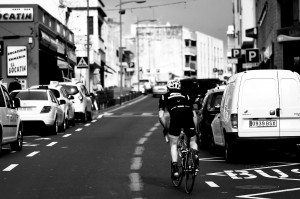Expect cars & buildings in Tenerife!
 I still get the odd complaint (or rather, observation) that there are a lot of cars on Tenerife. So in keeping with this being an information site, I’ll be totally honest and admit that, yes, there are a lot of cars on this island. I still feel a little responsible for this perception as I took all the photos on the website and being a photographer, I often wait until all the cars are out of a scene before taking any snaps. It doesn’t really make sense to promote a cycling website by including a load of ugly cars in the photos, does it? My point here is that you won’t see many cars or trucks on any tourism website cycling or otherwise.
I still get the odd complaint (or rather, observation) that there are a lot of cars on Tenerife. So in keeping with this being an information site, I’ll be totally honest and admit that, yes, there are a lot of cars on this island. I still feel a little responsible for this perception as I took all the photos on the website and being a photographer, I often wait until all the cars are out of a scene before taking any snaps. It doesn’t really make sense to promote a cycling website by including a load of ugly cars in the photos, does it? My point here is that you won’t see many cars or trucks on any tourism website cycling or otherwise.
Generally people used to cycling in city traffic will find local drivers are very polite towards cyclists here. If you live in the country though, it might not be for you.
In that case, have a look at the population density of the place you are travelling to. Note that Tenerife’s average population density (442/km²) is higher than Japan’s (337.1/km²). Have a look at google street view at a few places along the routes you have planned. I have travelled a lot and I know that you just can’t appreciate the world through a computer screen, so do try to put things into perspective when doing this. In other words, there are ugly scenes anywhere in the world…
Managing your expectations while travelling overseas:
Much of how you perceive a place depends not on the place itself! It also depends on your attitude going into a new trip, whether you’re more of an optimist or a pessimist, your current mood, and also who you are travelling with. There are a few other variables I’ve noticed: those all-important initial impressions you get about a city or an island. You know, the very first feelings you get upon final approach to your destination. Like when you look down upon from the plane coming in to land, out that train or bus window, step outside the confines of the airport or even just walking around after you arrive.
Not just that, but we often have preconceived ideas about towns and cities. You might have been judging a place on it’s name, building up this picture in your mind’s eye before you even get there. Then you quickly find out that those thoughts you had turn out to be totally wrong (even if you have seen photos previously).
It’s certainly happened to me more than once. For some strange reason I thought that the tower of Pisa was situated on a grassy knoll. That is not the case and I am not the only one to have thought the exact same thing.
So it’s worth remembering that approximately 5 million people visit this island per year. There are hundreds of hotels and apartments. So of course there are buildings. I know it’s hard, but be realistic when you travel! If you imagine the worst, you will never be disappointed -you may however decide not to go and then you’d be missing out on something. On the other hand, if you think that somewhere is going to be some kind of previously undiscovered paradise, it’s a sure sign that you’re setting yourself up to be let down.
I try to do a bit of ‘research’ about a place before I travel anywhere (and I almost never visit the same place twice). I learn the basics such as «hello» (hola), yes (sí) and no (no), what the local currency is, how to get around, what’s worth seeing and little else. It’s all too easy to read too much and then turn yourself off the whole region! I think it’s important to have sufficient information so that you can decide for yourself whether you think a place is worth visiting (that goes for anywhere, not just here). In summary, some of my fondest memories of all time about travelling the globe have come from some of the least anticipated cities.
TIP:
Generally there is a lot less traffic the further you get away from the main resorts in Adeje, Puerto de la Cruz, etc. There are faaaaar less cars up in the mountains, be it Teide, Teno or Anaga. See this map for example. Santa Cruz is a small city and the whole region is urbanised. If you happen to be staying in Santa Cruz, all is not lost, because it is still very close to the Anaga mountains and is also fairly close to the La Esperanza climb too!
If you’re on holiday, the best time to cycle around these three zones (Teide, Teno and Anaga) is during the week after about 9am. The only time this doesn’t hold true is when snow (or ice) falls on Mt Teide and that freshly fallen snow also coincides with a weekend or local public holiday. In that case, every man and his dog wants to go up there – roads are frequently open in one direction only to prevent a massive traffic jam (up via Vlifalor, down via La Orotava). Sunday mornings are also a quiet time to ride.
Traffic can actually be worse earlier in the morning on the weekdays as most jobs are service-industry types of jobs: many people start work at 8:00am or earlier. So many citizens will literally «be coming down the mountain» on weekday mornings. I can speak from experience and say that during the Winter, you can expect a rather nasty queue on the TF5 highway some time around 7-8am somewhere between La Laguna and El Sauzal (in the direction of Santa Cruz at least). Likewise, during peak hour there is usually a line of cars waiting around the entrance to Golf del Sur. And sometimes Los Cristianos if there is an accident. See more information about this here. Note that cycling is prohibited on TF1, TF2 and TF5 anyway, so this info is mainly in case you are travelling by other means…
My Advice? I personally wouldn’t cycle on TF47. I see a a fair few cyclists on the short climb back through Armiñime in the direction of Las Americas and no that bit doesn’t look fun at all. If this bothers you, then you should consider renting a car [ironic I know as you are now contributing to more traffic] and starting your rides at Las Mercedes, Igueste, La Esperanza, Los Pinos / Aguamansa, La Camella / Vilaflor, etc. Americans would call these places the «city limits». TF5 between Puerto de la Cruz & Icod is pretty, but also pretty busy.
I think if you take the time to explore Tenerife, go into the more rural zones, take the road less travelled so to speak, you will be rewarded. Also, don’t forget that the centre of some towns such as La Orotava and La Laguna are quite historic. Even Santa Cruz has its charms. It’s well worth taking a day out by bus to explore these places on foot. They are also great places for Street photography. You’ll also be helping to boost the local economy and Spain needs that right now. So take the time out and go and visit an old tapas bar for lunch or something!





Discussion Area - Leave a Comment